Women’s football in Italy has progressed massively these past few years, with clubs such as Juventus, Fiorentina, Roma, Inter and Milan developing their own competitive teams in order to join the fight for the Serie A Women’s title. Maurizio Ganz, Milan’s manager, has built a strong and determined team which currently occupies the second place in the table, level on points with Fiorentina and behind leaders Juventus. Second place would secure qualification to the Women’s UEFA Champions League.
This tactical analysis in the form of a scout report will analyse the impact of Ganz’s tactics in shaping Milan’s recent success before the interruption of football due to Covid-19.
Ganz has utilised a plethora of formations and tactical systems and a consequence of this is that his side are incredibly flexible. Therefore, his players have gained experience, tactical versatility and most importantly, the ability to play in different positions and various formations. When analysing formations, it is clear that Ganz has alternated between four formations in the 13 matches played this season, which shows us a brief glimpse of Ganz’s tactical fluidity. His tendency to alter his team’s tactics in order to combat an opponent’s strengths is quite apparent when we take into consideration that Ganz has never deployed the same formation in consecutive matches more than three times.
However, not only do his pre-match tactics change, Ganz often changes his tactical system during matches, most commonly to aid his team’s attacking play. As well as tactical changes and tactical flexibility, Ganz is a firm believer in total football and uses several tactical systems as tools to accomplish his long-term aims with the club. These tactical choices and their effects on the team’s performance will be addressed thoroughly in this analysis while using various examples to support these ideas.
Midfield tactics
Milan’s 4-3-3 formation is composed of a defensive line consisting of two centre-backs flanked by attacking full-backs who are always looking to get forward and support the wingers, but are also able to get back quickly and fulfil their defensive roles when possession is lost. In midfield, Refiloe Jane occupies the role of defensive midfielder; she forms the head of a triangle that includes herself and two other central midfielders. These three players are the basis of Milan’s tactical system. With defensive interceptions or key passes, they constitute the most fundamental part in Ganz’s defensive and attacking system.
The result of Milan’s full-backs getting forward is that it alters Ganz’s system to resemble a 2-5-3, leaving only the two centre-backs who adopt a high defensive line. The image below displays this system. By overloading the midfield, it forces the opposition to press high to mark the midfielders and leaves space in between the lines. This is of great benefit to Ganz’s team as it is easier for players to find space to receive the ball with time to turn and drive at the opposition defence.
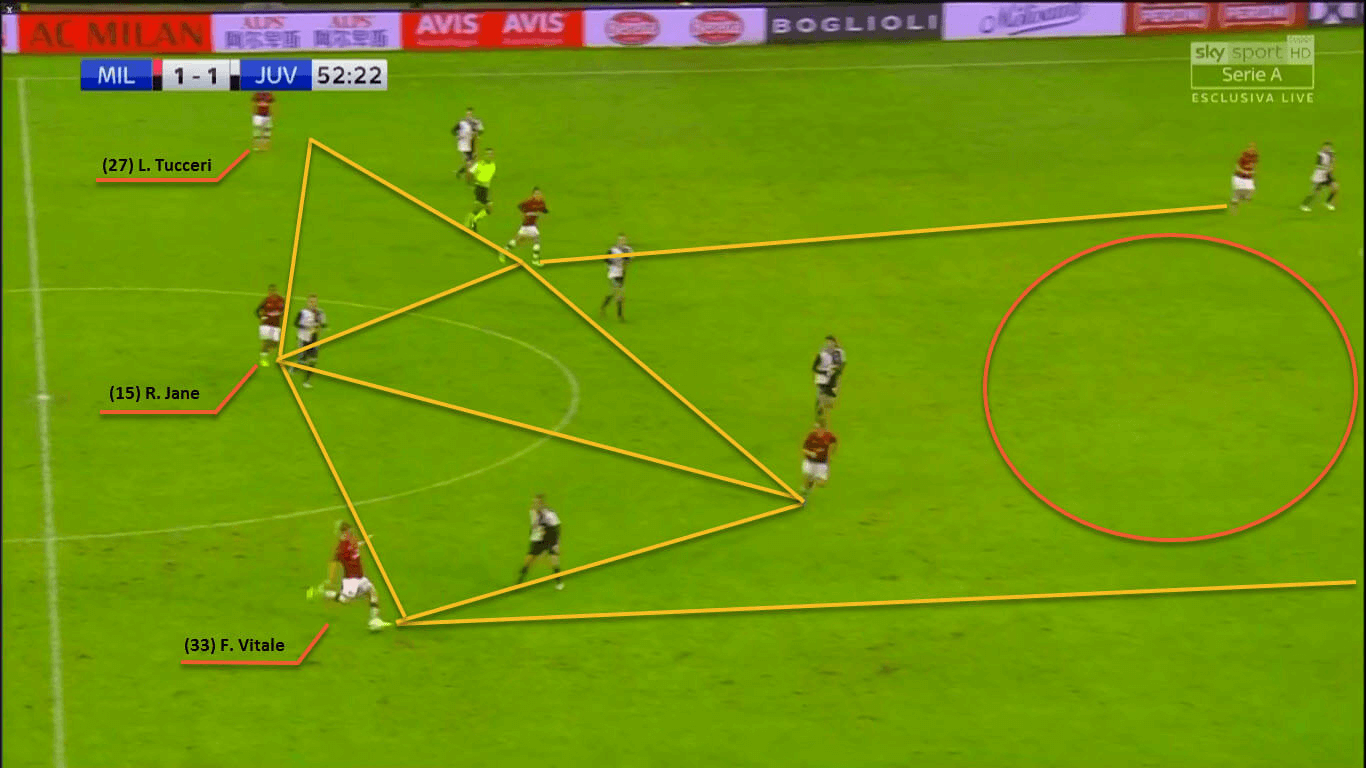
This tactical tweak enables Milan to get the ball to one of their forwards in dangerous positions. The forwards are rapidly supported by two central midfielders, and in some cases by three. One of the central midfielders will often move into a number 10 role and will operate in between the midfield and attacking lines.
We can see an example of this below, Nora Heroum has moved in a position typically associated with a number 10. We are also able to see right-back Francesca Vitale having an influence in the final third as we discussed earlier.
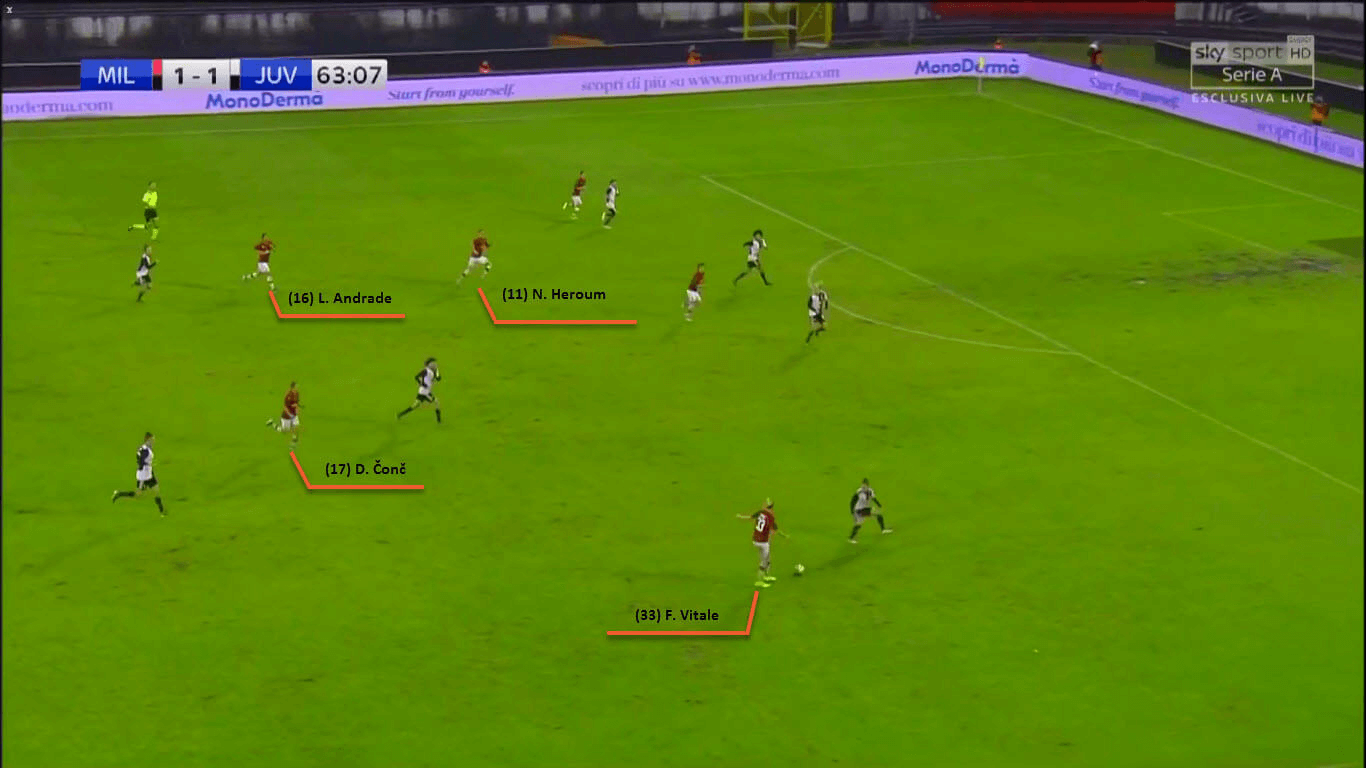
Ganz’s system encourages positional fluidity, with the aim of confusing opposition defences. He relies on intelligent movement off the ball to create passing triangles in several areas of the pitch to exploit space.
Efficiency in attack
In the 2019/2020 season, Ganz has adopted an attacking tactic that is noteworthy because of the variety of concepts it contains, especially considering that Ganz has only managed the team for a short period of time. Furthermore, Milan have made use of three different attacking systems this season. The team alternated between attacking with two wingers and a forward, one attacking midfielder and two strikers, one single forward followed by five midfielders and at times Milan also played with two forwards and four midfielders, and this validates the versatility of Ganz’s attacking philosophy.
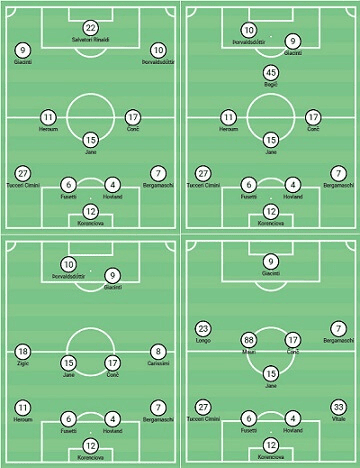
In order to grasp the aims intended by Ganz utilising several systems in his short time as manager, we could argue that a possible reason for Ganz’s indecision in his tactics could be the manager’s lack of coaching experience or the fact he is yet to find the system that best suits his players. However, when analysing Milan’s play, it is clear that Ganz knows exactly what he wants his team to do.
Ganz has used four different tactical systems in an attempt to surprise his opponents and to restrict them from being able to plan their defence accordingly. This would not have been possible without the hours of work on tactics that Milan have done in training . For instance, in the last five matches Valentina Bergamaschi played as right-back, right midfielder, left midfielder and at times she also played as a forward. During a single game, Bergamachi played as a right midfielder, then switched to the left before playing as a forward for the last few minutes.
Furthermore, Valentina Giacinti, Milan’s captain and top scorer, has been used intelligently to implement Ganz’s attacking plans. Changing her position from being a striker to a left-winger and back to being forward during the same matches proved beneficial for the team as it helped to create goal-scoring opportunities and frustrated the opposition who were tasked with marking Giacinti, only to find that she had changed position. What made this positional fluidity even more effective was the arrival of a talented forward named Berglind Björg Þorvaldsdóttir. Ganz often deployed her as a centre forward with Giacinti as left winger and at other times Þorvaldsdóttir was a second forward alongside Giacinti.
Playing with these two forwards together was beneficial especially in creating space and providing options for a teammate in possession. We can see in the next image Þorvaldsdóttir positioned herself in a perfect position to receive the ball and giving Giacinti an alternative option in this counter-attack.
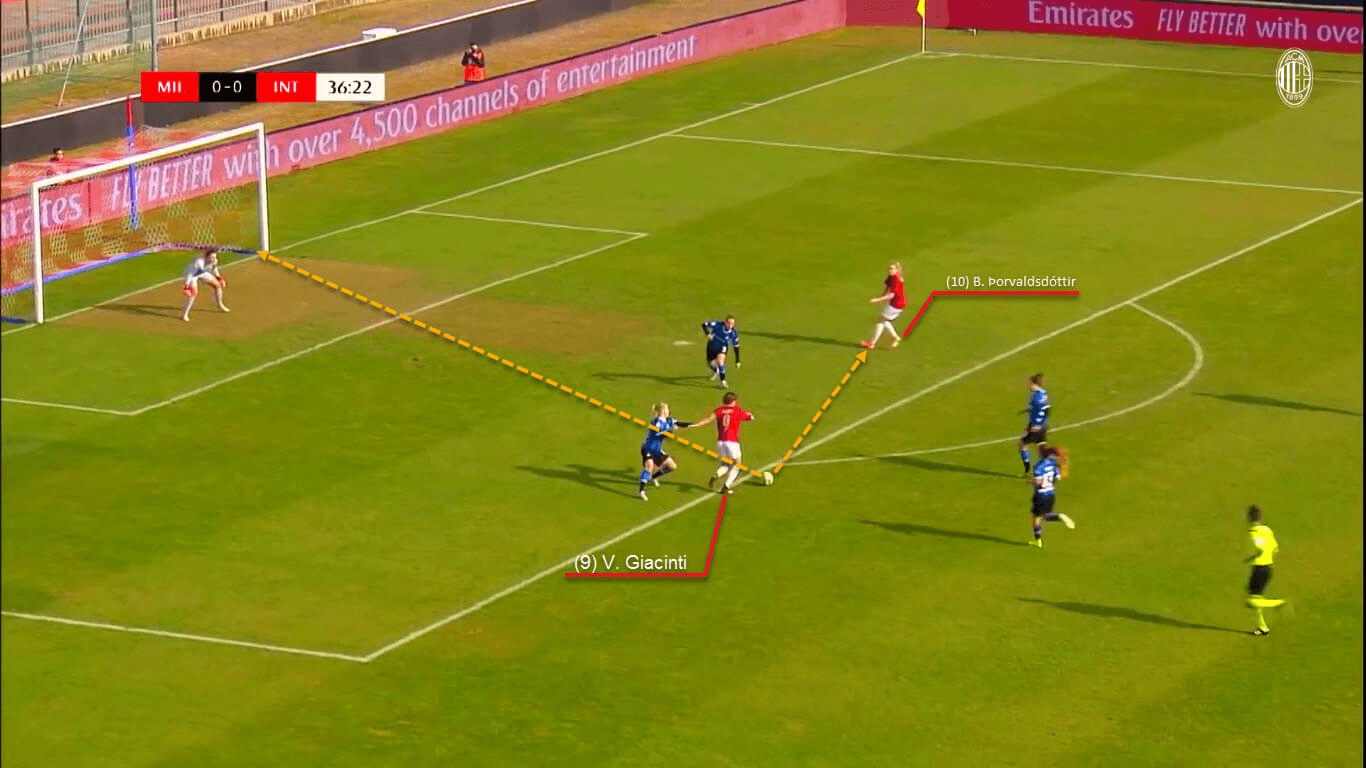
Another tool that Ganz uses for creating scoring chances is the reliance on midfielders to make late runs in order to provide another attacking option in the final third and further confusing the defence. This was a recurrent theme in Milan’s games especially in the Derby against Inter when the central midfielder, Dominika Čonč, managed to score two goals after receiving a forward pass.
Milan forwards do not only aim for personal achievements in the final third. They value the team’s success above personal accolades and if they feel that their teammates are in a better position to score, they will look to play them in rather than attempting a more difficult shot themselves.
We can see below, Deborah Salvatori Rinaldi passes the ball to Čonč and immediately attempts to block two defenders. Even though she failed to do so, she helped give Čonč a few precious seconds to control the ball. Meanwhile, the other forward Giacinti blocked the defender who was trying to block Čonč’s shot from reaching the goal. This tactical awareness exhibits the teamwork that characterises how Milan’s forwards aid the team to score many goals.
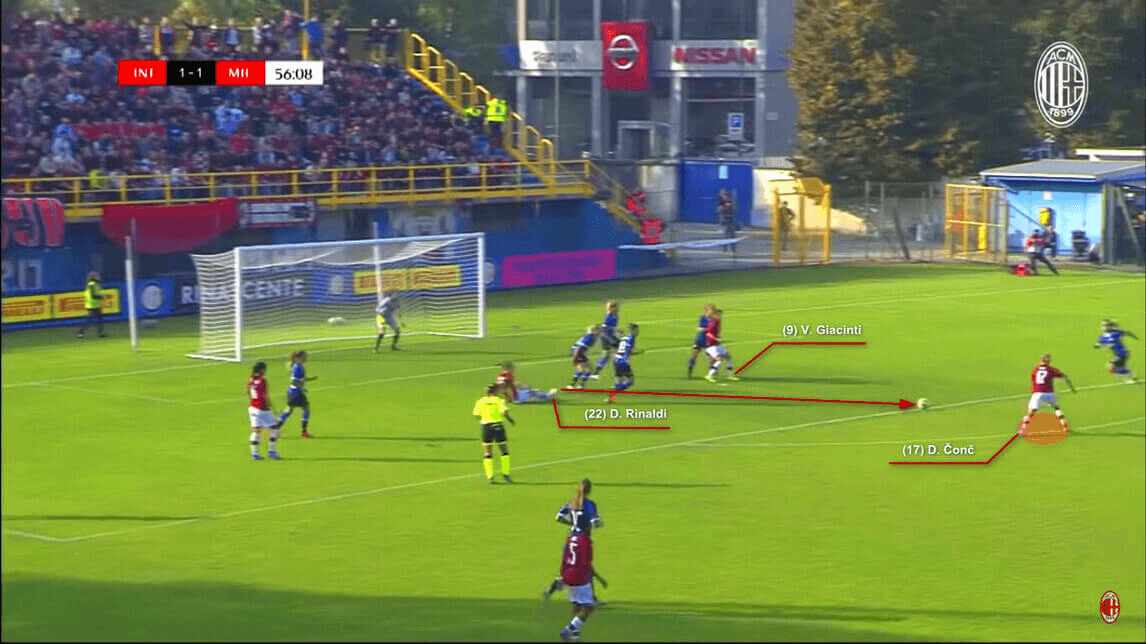
Defensive structure
Ganz’s team relies on collective pressure starting from the final third – a strategy that includes the forwards as well. The forwards and wingers often drop back into midfield and look to pressure the opposition when they attempt to play into midfield, and when regaining possession look to launch quick counter-attacks.
This positional pressing was key to many goals this season and it confirmed, once again, Giacinti’s effectiveness on the left. Giacinti not only scores goals but also makes many recoveries via tackles or interceptions despite being primarily an attacking player. The same applies to Bergamaschi as well. We can see an example of Milan’s pressing in the example below. Giacinti allows no room for Juventus’ defender to pass to her teammate while Bergamaschi and Čonč are keeping an eye on the other central defender to close her down if she receives the ball.
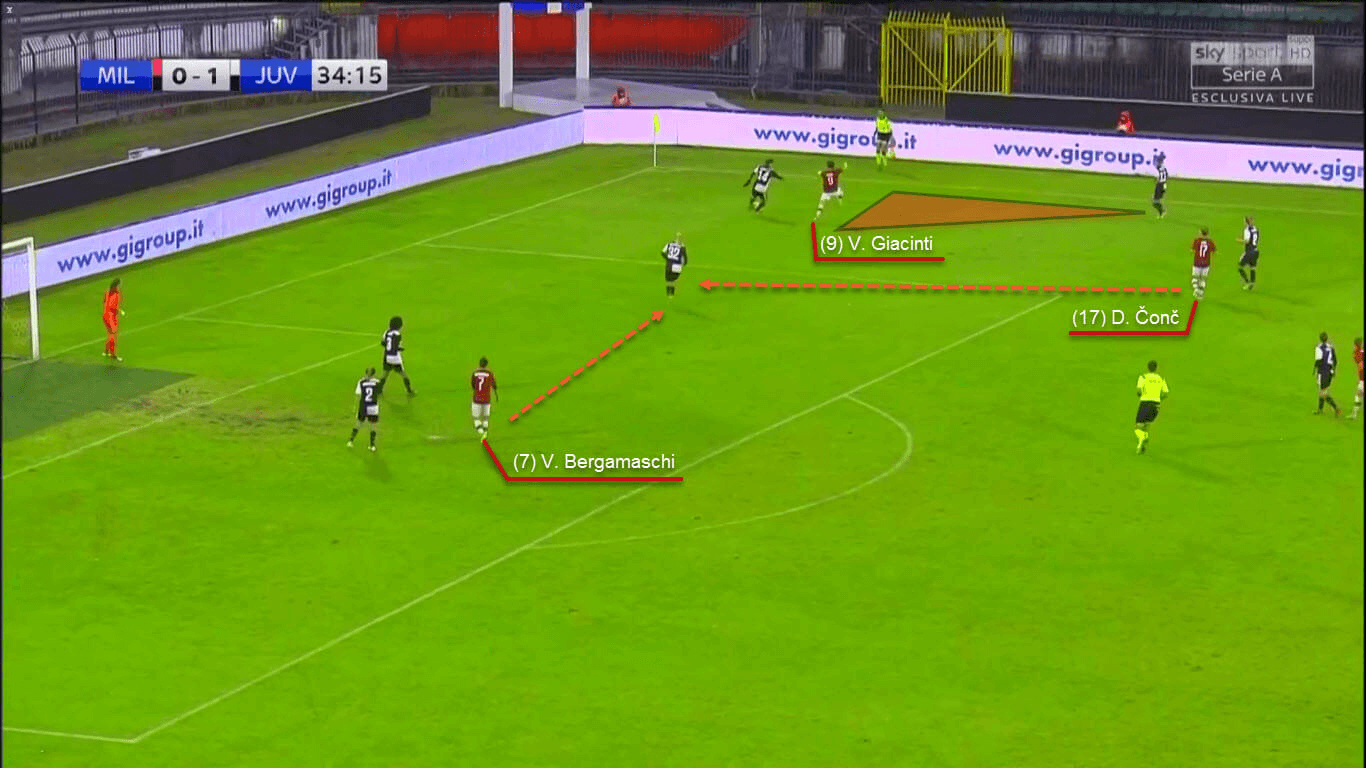
When it comes to the defensive structure of the team Ganz is rather constant in his choices. He plays with four defenders and three midfielders ahead of them, usually using a box to box midfielder who drops to support the defensive line and two central midfielders who try to prevent the opposition playing through the middle and to support their full-back when attacking teams attack in wide areas. However, in the following example, we can highlight flaws in the tactical approach of the team when closing down an attacking player.
A Roma player escapes the pressure from Milan’s midfield and drives towards the penalty area, instead of stepping out and challenging her, the defence keeps backing away, allowing her to continue her run into space. Where she is able to get the ball out of her feet and have a shot on goal, scoring in the process. These errors are mainly due to the spaces left in between lines and the midfield not recovering their defensive positions quickly enough in transitions, as well as the lack of pressure from defenders who tend to drop off allowing opposition forwards to reach the final third.
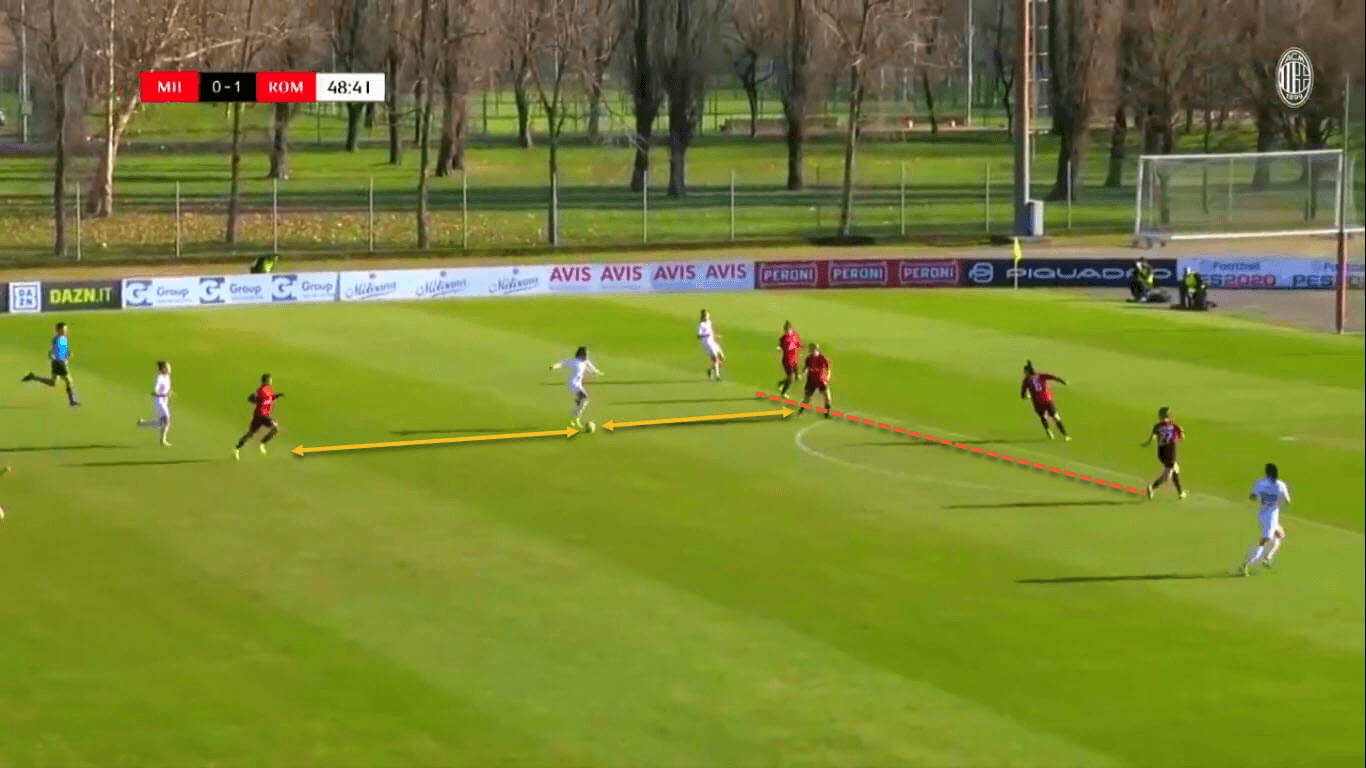
Linda Tucceri’s role in winning defensive duels is highlighted in the following image. She has won 23% of the entire team’s defensive duels in the last five games while the Finnish midfielder Heroum comes second with 12.4%. This showcases the defensive strength of Milan in midfield and on both flanks while it also shows that the number of interceptions made in the centre of defence are much less, this has led to many goals this season.
Why? Their lack of defensive experience and inconsistency remaining compact are the main reasons for these flaws, along with only being in their second season in Serie A Women.
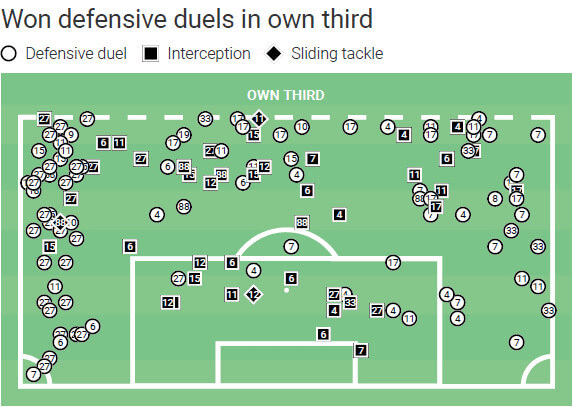
Key players
With nine goals scored this season, Valentina Giacinti is the highest scorer of the team as she is ranked fourth in the league’s top scorers. Her contributions in both the attacking and defensive phases are vital and her excellent form during the first half of this season proves her worthy of being the team’s captain. What is fascinating with Giacinti is her ability to dribble past defenders with pace and determination as well as her intelligent pressing when she plays as forward. Her ability to play various positions is crucial to Ganz’s Milan. Her crucial interceptions have often resulted in goal scoring opportunities, why? Because she has great vision, she has the ability to play key passes, ten of which have been in the last five games.
The revelation of this year’s Milan side was Þorvaldsdóttir who came on loan from Breiðablik in January. The Icelandic forward scored five goals in four matches. In her debut, she helped turn the tables on Roma after scoring two vital goals when Milan were losing 2-0. Her arrival boosted Milan’s attacking performances as she relieved some of the pressure on Giacinti. We can see below, the Icelandic gave a precious alternative for Ganz that allowed him to dominate opposition defences. However, due to her time at Milan only being a loan, Þorvaldsdóttir will be missed by her teammates, Ganz and the Milan faithful as she returns to Iceland.
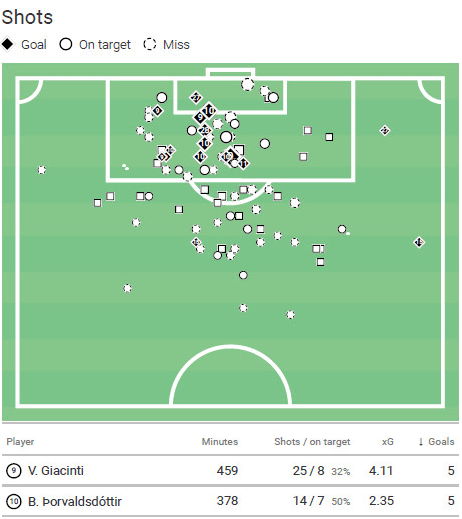
The Slovenian Dominika Čonč was also very effective this year in Milan’s midfield. She added value in Milan’s midfield as she was able to score five goals and helped create many others. Her work rate enabled her to make 12 recoveries in the final third that frequently led to goal scoring opportunities. Her passing and crucial interceptions helped the team a lot, especially in the build-up. In the following picture, we see Čonč’s passing from a recent match, which shows her key importance in Milan’s transition.
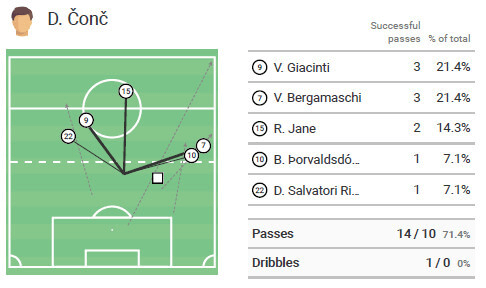
Another key player for this Milan team is the 22-year-old Valentina Bergamaschi. What makes her contribution unique is her versatility and ability to play in different positions without necessarily dropping the level of her performance. Throughout this season, she has been able to secure 15 starts whilst alternating between playing in defence, midfield and attack. Bergamaschi could be considered manager Ganz’s joker, due to her versatility. Although her influence is not reflected in scoring goals, her long runs, crosses, interceptions and teamwork in general have hugely contributed to Milan’s form.
Conclusion
To conclude, this Milan side are progressing at a fast pace, considering that this is only their second year of existence. With a manager like Ganz they are more likely to develop into being real competitors for both the Serie A Women and the UWCL in the coming years. It is worth mentioning that even though the team includes some young and inexperienced players, they were able to cope with the various tactical systems utilised by Ganz and they also benefited from some very talented players like Giacinti, Þorvaldsdóttir, Čonč, Bergamaschi, Hovland, Vitale and more.




Comments